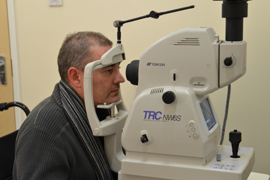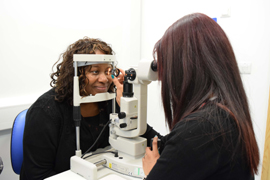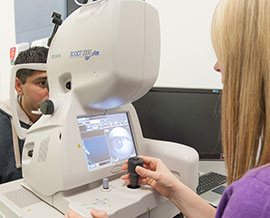Every 1 to 2 years anyone who has diabetes and is aged 12 or over will be offered a routine diabetic eye screening test.
Photographs of the back of your eye will be taken. An expert studies the photographs of your eyes after you have been screened. In some circumstances you may be called back to attend another type of screening as per below.
Digital Surveillance Appointment
Digital Surveillance appointments are made to closely monitor any changes found during your annual routine diabetic eye screening test. Digital Surveillance screening is

offered every 3, 6, 9 or 12 months depending on the type and progression of the changes to your eyes.
If images of your retina show signs of improving you may be returned to routine annual screening. If images of your retina confirm signs of serious changes, you may be referred to a hospital eye service for further investigation or treatment.
Slit Lamp Assessment

Slit Lamp appointments are made if photographs taken during your routine eye screen did not give a clear enough view of the back of your eyes.
Drops will be put in your eyes to allow your pupils to dilate, or get bigger. The Slit Lamp allows for a 3D examination of the back of your eyes.
Eye screening during your pregnancy

Pregnancy can increase the risk of rapid progression of diabetic retinopathy. All antenatal patients should be screened within their first trimester and then at set intervals during pregnancy.
Screening for pregnant patient is undertaken in the Digital Surveillance clinics.
Optical Coherence Tomography (OCT) Clinics

OCT is used for evaluating the layered structure of the back of your eye (the retina) and is used to determine if there is any ‘swelling’ (macular oedema). Macular oedema is harder to detect on the traditional 2D digital photographs used for screening.
Images captured in OCT clinics are graded by experienced retinal screeners and reviewed by consultant ophthalmologists who decide the clinical outcome; either a return to annual screening, continue OCT (at 1-9 month intervals) or a referral to the Hospital Eye Service.
When patients attend their screening appointment they will have their eyes photographed as normal. Our experienced retinal screeners look for specific indicators of clinically significant macular oedema, and if any are detected, an OCT will be carried out on the patient to see if there is any thickening of the retina. Our aim is that using our OCT service will reduce patients getting unnecessary appointments to the hospital eye service and will reduce patient anxiety.
